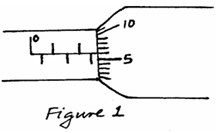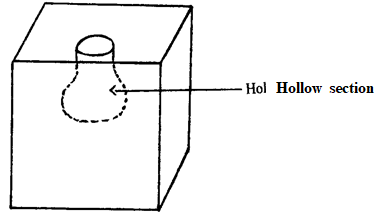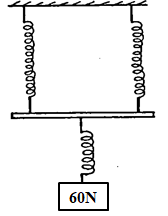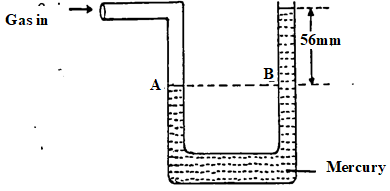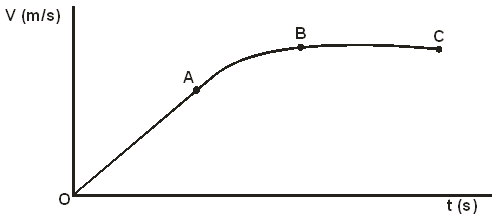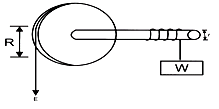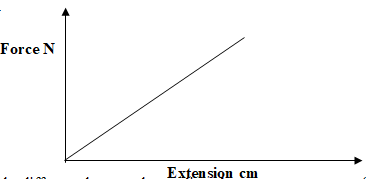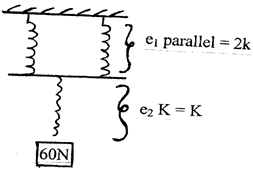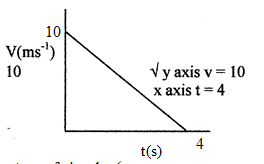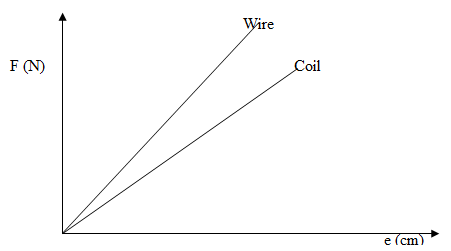INSTRUCTIONS TO CANDIDATES
- The paper consists of two sections, Section A and B.
- Answer ALL the questions in section A and B in the spaces provided.
- ALL answers and working MUST be clearly shown.
- Mathematical tables and electronic calculators may be used.
SECTION A (25 MARKS)
Answer ALL the questions in this section in the spaces provided.
- A micrometer screw gauge is used to measure the thickness of a stuck of 10 microscope slide cover slips. The reading with the cover slips in position is as shown in figure 1.
If the micrometer screw gauge has a negative zero error of 0.01mm, determine the thickness of each cover slip. (2 marks) - Explain briefly why water will wet a glass surface but mercury will not. (2 marks)
- The figure below is that of a uniform meter rule supported at the 30cm. A load of 5N is attached at the 0cm mark and that of 2N to a pulley at the 100cm mark. Calculate the weight of the meter rule. (3 marks)
- A mercury barometer reads 75cmHg at the base of Mt.Kenya. Assuming that the height of the mountain is 1088m and the average density of air is 1.25kg/m3. What is the reading of the barometer at the top of the mountain? (Take density of mercury is 13.6g/cm3.) (3 marks)
- The figure below is a rectangular block in a stable equilibrium, with a hollow section as shown.
- What is the effect of adding water into the hollow section? (1 mark)
- What could be the reason for your answer above? (2 marks)
- The figure below is that of identical springs. A 60N weight is attached on the springs as shown so that the total extension for the system is 6cm. Calculate the spring constant of one spring. (3 marks)
- .The system in the figure below is in equilibrium at room temperature. The system is taken outside where the temperature is 100C higher for some time.
Explain why it tips to the right when it is taken outside the room. (2 marks) - State one way of increasing sensitivity of mercury in glass thermometer. (1 mark)
- A tightly fitted bottle cork will be easier to remove if the bottle is warmed. Explain this using kinetic and thermal property of matter. (2 marks)
- A bullet of mass 20g moving with a velocity of 30m/s penetrates a sand bag and it’s brought to rest in 0.05 seconds. Find the average retarding force of the sand. (3 marks)
- Explain why an iron gate feels colder when touched but its wooden gatepost feels warm at night. (1 mark)
SECTION B (55 MARKS)
Answer ALL the questions in this section in the spaces provided.
- Distinguish between streamline and turbulent flow. (2 marks)
- The figure below shows two light sheets of paper arranged as shown.
Explain the observation made when air is blown at the same speed and time at points A and B. (2 marks) - The figure below shows an incompressible fluid moving through a tube of varied cross- sectional area. If the area of the small tube is 0.05m2, calculate the diameter of the large tube in cm. (3 marks)
- Use the figure below to answer the questions that follow.
- What pressure is acting on point A? (1 mark)
- What is the value of pressure difference in the instrument reading? (1 mark)
- If the atmospheric pressure is 760mm of mercury, what is the value of gas pressure? (2 marks)
- In an experiment to estimate the size of oil molecule an oil drop of diameter 0.05cm spreads over water to form a circular patch whose diameter is 15cm.
- Explain why the oil spreads over water. (1 mark)
- Determine:
- Volume of the drop. (3 marks)
- Area of the patch. (3 marks)
- State two assumptions made in b)(ii) above. (3 marks)
- The figure below shows a velocity – time graph for the motion of a certain body.
- Describe the motion of the body in the region:
- OA: (1 mark)
- AB: (1 mark)
- BC: (1 mark)
- A car moving initially at 10m/s decelerates at 2.5m/s2
Determine:- Its velocity after 1.5seconds. (2 marks)
- distance travelled in 1.5 seconds. (3 marks)
- The time taken for the car to stop. (3 marks)
- Sketch the velocity – time graph for the motion of the car up to the time the car stopped. (1 mark)
- From the graph determine the distance the car travelled before stopping. (2 marks)
- Describe the motion of the body in the region:
-
- A machine is a device that enables work to be done more easily and conveniently. State any two ways in which a machine makes work easier. (2 marks)
- Figure 7 shows a wheel and axle being used to raise a load W by applying an effort E. The radius of the wheel is R and of the axle is r.
- Show that the velocity ratio (V.R) of this machine is given by R/r (3 Marks)
- Given that r = 5cm and R = 50cm, determine the effort required to raise a load of 200N if the efficiency of the machine is 90%. (3 mks)
- State two reasons the efficiency of any given machine less than 100% (2mks)
-
- State Hooke’s Law. (1mk)
- The figure below shows the variation force with extension for a steel coil spring.
- On the same axes, sketch the variation of force with extension for a wire from which the spring is made. (1mk)
- Explain the difference between the two lines drawn (2mks)
- The following results were obtained in a experiment to verify Hooke’s law when a spring was extended by hanging various loads on it.
Complete the table for the extension e above. (1mk)Load (N) 0.00 1.00 2.00 4.00 5.00 6.00 Length of spring in cm 10.00 11.50 13.50 16.00 18.00 24.00 Extension 0.00 - Plot a graph of load (y-axis) against extension (3mks)
- From the graph determine the springs constant. (2mks)

MARKING SCHEME
SECTION A: (25MKS)
- Thickness of 10 cover slips = 2.56 + 0.01 = 2.57mm ✓ Thickness of each cover slip ✓ (2mks)
-
- Adhesion force between glass and water molecules is greater than cohesion force between water molecules✓
- Cohesion force between mercury molecules is greater than adhesion force between mercury and glass molecules✓
- 5×0.3 + 2 ×0.7 = w ×0.2 ✓
1.5 + 1.4 = 0.2w
2.0 = 0.2w✓
W = 14.5N✓ - Pressure due to mercury column = pressure due to air column ✓
(0.75 - X) 13600 ×10=1088 ×1.25 ×10✓
0.75 – X = 0.1
X = 0.65
Reading = 65cm Hg✓ -
- Stability of the block reduces
- Addition of water ✓ raises the position C.O.G✓
-
e1 + e2 = 6✓
e1 = 60/2K
e2 = 60/K
= 6/2K+ 60/K=6✓
= (60+120)/2K = 6
180 = 12K
K = 15N/cm✓ - Balloon will expand, therefore Upthrust on the balloon increases,✓thus clockwise moments increases more than anti clockwise moments✓.
- Having a thinner capillary tube ✓
- Gas inside the bottle expands, pushing the cork. ✓ The core expands more than the bottle hence becoming loose✓
- a = (v-u)= (0-30) OR Ft = m4v
t 0.05
= (-30) f = m4v
0.05 t
= - 600m/s2 = (0.02 ×30) = -12N
0.05
F = ma
= 20 × -600✓
1000
= -12N
Retarding force = 12N✓ - Iron gate when touched conducts heat away from the hand while wood does not because it is a poor conductor of heat ✓
SECTION B
-
- Steam line flow where all the particles of the fluid move in the same direction at the same velocity at a particular point: ✓ Turbulent: particle moves with different velocities. ✓
- The papers are observed to separate ✓ because of low pressure on the sides ✓A and B
- A1V1 = A2V2
0.05 × 2.6 = 0.1 × A2✓
A2 = (0.05 ×2.6) = 1.3m2 OR 13000cm2
0.1
Using πr2 = A
πr2 = 13000
3.142r2 = 13000
3.142
r2 = 4237
d = 2r
d = (√((r2 ) )) × 2
d = 128.65cm✓ -
- Gas pressure✓
- 56mm Hg✓
- 760mmHg + 56mmHg = 816mmHg✓
-
- Surface tension of water is stronger than that of oil
-
- Vol. = 4/3 πr³✓
= 4/3 × 22/7 ×(0.05)3
2
= 6.5476 x 10-5 cm3 ✓ - A = πr2
= 22/7×(15/2)2
= 176.786cm2✓
- Vol. = 4/3 πr³✓
-
- Oil drop is perfectly spherical
- Size of oil molecule is same as thickness of patch.
- Patch is one molecule thick. (Max. 2 marks)
-
-
- OA : object is accelerating
- AB: object is accelerating gently and non-uniformly
- BC: Object moving at constant speed
-
- u = 10m/s v = u + at
a = -2.5m/s2 = 10 – 2.5 × 1.5✓
t = 1.5sec = 6.25m/s✓ - s = ut + ½ at2
= 10 (1.5) – ½(2.5) (1.5)2 ✓
= 12.1875✓
= 12.19 - v = o
v = u + at
o = 10 – 2.5t✓
t = 10/2.5 = 45✓ -
- Distance = Area of triangle ✓
½ ×4 ×10
20m✓
- u = 10m/s v = u + at
-
-
(a)
- A small force (effort) is used to overcome a large force (Load)
- Less energy is expended in doing work
- Less time is used in accomplishing the task
✓ 2 for any two correct responses(2) (b) (i) - In one revolution, both wheel and axle complete one circumference
- V.R = Effort Distance/Load distance = 2 R/2 r
- V.R = R/r
✓ 1 mark for each bullet (b) (ii) V.R = 50/5 = 10
M.A = efficiency x V.R/100 = 90 x 10/100 = 9
Effort = Load/M.A = 200/9 = 22.22N✓1 mark
✓ 1 mark
✓ 1 mark -
- For an elastic material, the extension is directly proportional to the force producing it provided the elastic limit is not exceeded. ✓1
-
-
- The wire has a greater constant of elasticity 1 than material hence coil of the same greater gradient.
-
Load (N) 0.00 1.00 2.00 4.00 5.00 6.00 Length of spring in cm 10.00 11.50 13.50 16.00 18.00 24.00 Extension 0.00 1.50 3.50 6.00 8.00 14.00 - Suitable axes labelled ✓1
All points correct ✓1
Suitable line ✓1 - Springs constant K = çF ✓1
çe
Use students graph
Correct units ✓1
-
Join our whatsapp group for latest updates
Tap Here to Download for 50/-
Get on WhatsApp for 50/-
Download Physics Paper 1 Questions and Answers - Form 4 Term 1 Opener Exams 2023.
Tap Here to Download for 50/-
Get on WhatsApp for 50/-
Why download?
- ✔ To read offline at any time.
- ✔ To Print at your convenience
- ✔ Share Easily with Friends / Students

